Updated on 31/07/2025 by Silvija Meilunaite
Most of us do not eat enough fiber. Only 7% of adults meet fiber recommendations in America (6), and the situation is very similar in other Western countries. It is great that fiber is getting more attention, but why is it so important to us?
Let’s explore…
Fiber acts like a natural broom for our bodies. It moves through the digestive system, sweeping away waste and keeping everything running smoothly. It also feeds the good bacteria in our gut, which are responsible for our immune system and healthy digestion.
There are two types of fiber: Soluble and Insoluble.
Soluble fiber dissolves in water and forms a gel in the gut. It helps slow down digestion, stabilize blood sugar levels, and lower cholesterol. It also feeds good gut bacteria, acting as a prebiotic.
Insoluble Fiber does not dissolve in water. It adds bulk to the stool and helps food move faster through the digestive system, preventing constipation.
Most high-fiber foods contain a mix of both soluble and insoluble fiber, but some have more of one type. For example, oats, legumes, chia seeds, and citrus fruits are very high in soluble fiber. Whole grains, nuts and seeds, vegetables like broccoli, green beans, and fruit skins are high in insoluble fiber.
Key Benefits of Dietary Fiber
- Metabolic Health: Fiber helps to improve insulin sensitivity and reduce the risk of metabolic diseases, including type II diabetes and obesity. It also helps regulate blood glucose and lipid levels (the amount of fats in your blood, mainly cholesterol and triglycerides). (1)(2)(3)
- Cardiovascular Health: It helps reduce cholesterol levels, particularly LDL or bad cholesterol, and improves overall heart health. (1)(3)
- Gut Health: Fiber helps to maintain gut microbiota healthy. It promotes the growth of beneficial bacteria, which produce short-chain fatty acids that support gut health and reduce inflammation. (4)
- Colorectal Cancer Prevention: One of the benefits of fiber is the improved gut motility and the speed up of waste passage. This may help lower the risk of colorectal cancer and other intestinal diseases. (3)(5)
- Weight Management: Fiber promotes satiety, supporting weight management and preventing obesity. (5) Fiber-rich meals can also reduce your calorie absorption. Certain fibers can bind to dietary fats in the gastrointestinal tract, reducing fat absorption (9). It’s quite small, but it can add up, especially if you’re eating a whole food plant-based diet.
- Reduces Inflammation: Fiber helps with inflammation by feeding beneficial gut bacteria, which produce short-chain fatty acids that calm the immune system. It also helps regulate blood sugar and lower cholesterol, both of which are linked to chronic inflammation. (6)(3)
To summarise: Fiber keeps our gut happy, our blood sugar steady, our immune system strong, and our whole body healthier.
How much fiber should we eat?
Health guidelines recommend eating 14 grams of fiber for every 1,000 calories daily. (6)(7). So if you are roughly consuming 2000 calories a day, you should aim for 28-30 grams of fiber, or 10 grams of fiber per meal.
You should increase fiber slowly and drink enough water to avoid bloating and gas, cramps, and constipation or diarrhea.
Like with everything in life, try not to overdo it, as it can lead to reduced absorption of minerals like iron, zinc, or calcium.
Now we know how good fiber is for us, and how much we should consume, let’s see how we can get it. Here are the top foods that are very high in fiber.
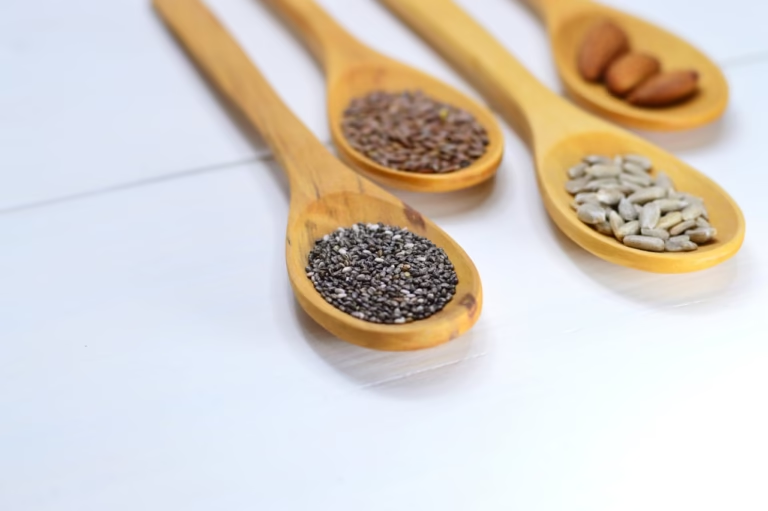
1. High Fiber Seeds and Nuts (per 28g serving):
Chia Seeds 10g
Flaxseeds 8g
Poppy Seeds 6g
Sesame Seeds 4g
Almonds 3.5g
Sunflower Seeds 3g
Pistachios 2.9g
Pecans 2.7g
Hazelnuts 2.7g
Pine Nuts 2.7g
Pumpkin Seeds (Pepitas) 2g
Walnuts 2g
Cashews 1g
Hemp Seeds 1g
Easy Tips:
- Sprinkle mixed seeds on salads, porridge, desserts, and stews for crunch and extra fiber.
- Make chia seed puddings or add them to porridge.
- Grind and sprinkle flax seed on dishes; they are almost tasteless but packed with fiber. Make sure they are grounded for your body to be able to absorb the nutrition. Store ground flaxseeds in the fridge to keep them fresh.
- Add poppy seeds to baked goods.
- Make hemp seed milk; they are higher in protein (9g per serving) compared to most seeds (~6g). Add them to your smoothies or sprinkle them on the food.
- Keep a jar of mixed nuts and seeds ready for easy sprinkling on meals!
- Drink Basil seed lemonade
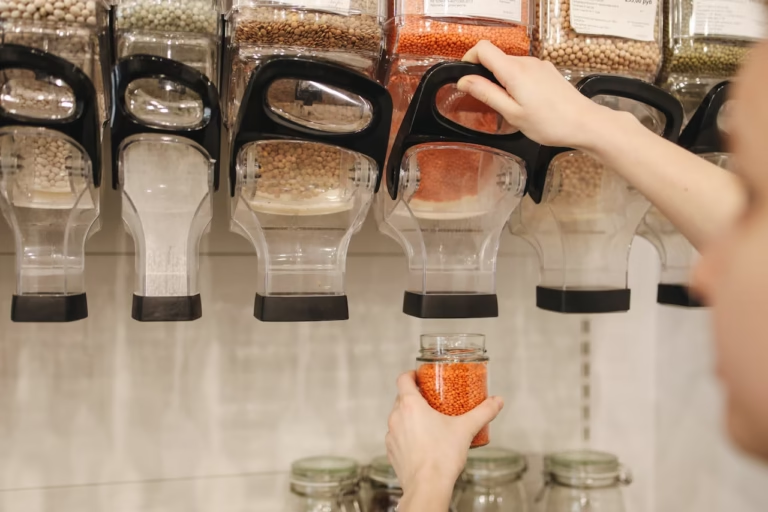
2. High Fiber Legumes (per 1 cup cooked):
Legumes are the plant group the highest in fiber, so make sure to include them in your meals.
Navy Beans 19g
Soybeans 17g
Lentils 15.6g
Black Beans15g
Pinto Beans 15g
Split Peas 6g
Chickpeas 12.5g
Kidney Beans 13g
Green Peas 8.8g
Edamame 8g
Easy Tips:
- Make hummus using a mix of chickpeas and beans.
- Stock up on frozen edamame for pastas, soups, and stir-fries.
- Choose soy milk, which is high in both protein and fiber. Learn more about plant-based milk nutrition here
- Stock up on precooked or dried different kinds of beans – they are so versatile and can be added to salads, tacos, stews, pastas, or simple toasts.
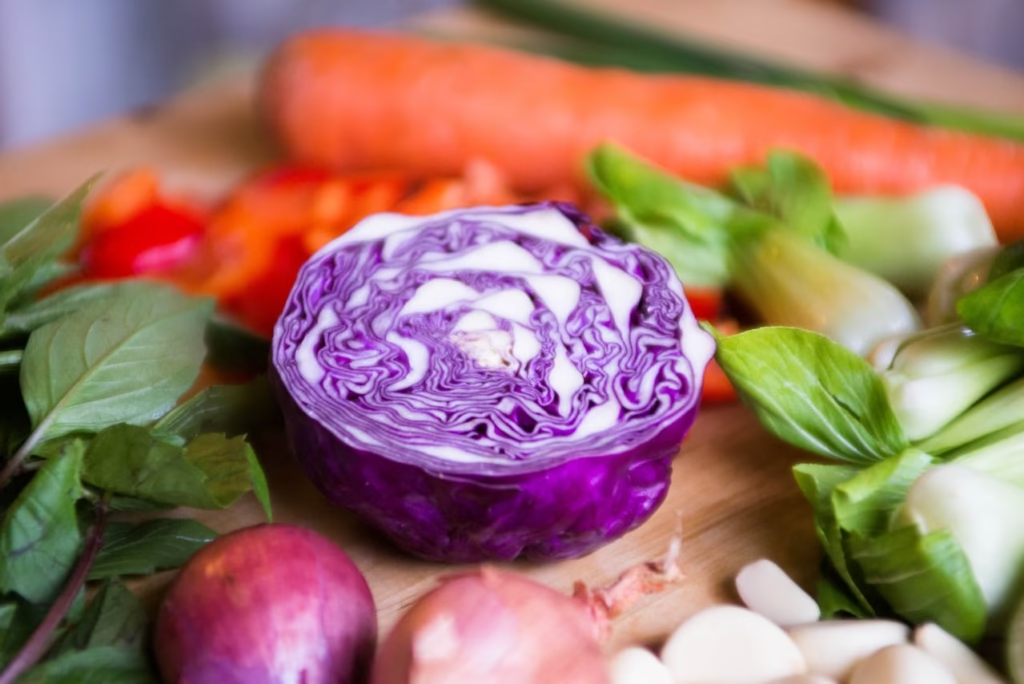
3. High Fiber Vegetables (per 1 cup cooked):
Artichokes 10.3g
Green Peas 8.8g
Sweet Potatoes (with skin) 6.6g
Parsnips 6.2g
Collard Greens 5.3g
Broccoli 5.1g
Turnip Greens 5.0g
Carrots 4.8g
Spinach 4.3g
Cabbage 4.2g
Brussels Sprouts 4.1g
Kale 4.1g
Okra 4.0g
White Potatoes (with skin, boiled) 3.8g
Beets 3.8g
Swiss Chard 3.7g
Cauliflower 3.5g
Bell Peppers 3.1g
Asparagus 2.8g
Eggplant (with skin) 2.5g
Zucchini (with skin) 2.0g
Easy Tips:
- Eat a variety of vegetables daily, make them your star dish, not a side.
- Buy organic veggies and eat them with the skin ( when edible) as most of the fiber is in or just under the skin.
- Eat veggies in season or frozen for more nutrition.
- Cooling cooked potatoes creates resistant starch, feeding good gut bacteria.

4. High Fiber Fruits and Berries(per 1 cup)
Avocado 10g
Guava 9g
Raspberries 8g
Blackberries 7.6g
Pomegranate Seeds 7g
Pears (with skin) 5.5–6g
Apples (with skin) 4.5–5g
Figs (fresh) 5g
Bananas 3g
Kiwi (with skin) 5g
Oranges 3.5–4g
Blueberries 3.5g
Strawberries 3g
Mango 3g
Apricots (fresh) 3g
Plums 2.5g
Cherries 2.5g
Papaya 2.5g
Grapes 1.4g
Easy Tips:
- Berries (especially raspberries and blackberries) are among the best fiber sources.
- Always eat pears and apples with the skin!
- Eat a Kiwi with the skin (scrub under water first to reduce fuzz).
- Buy frozen berries and fruits, they’re fresher and cheaper!
- Add your fruit and berries into smoothies, porridge
- Blend frozen fruit and berries for a refreshing, naturally sweet ice cream.
- If you buy non-organic fruit and berries, soak them in water with soda and rinse them afterward. It will help to get rid of pesticides, especially if you eat them with your skin.
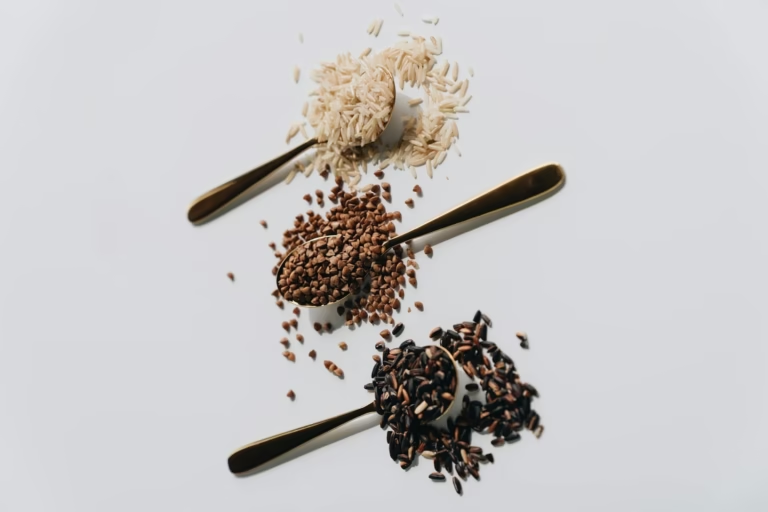
5. High Fiber Whole Grains(per 1 cup cooked)
Bulgar (cracked wheat) 8g
Spelt 7.6g
Teff 7g
Barley (hulled) 6g
Amaranth 5.2g
Quinoa 5g
Farro 5g
Whole Wheat Couscous 5g
Sorghum 5g
Oats (steel-cut or rolled) 4g
Buckwheat 4.5g
Brown Rice 3.5g
Millet 2.3g
Easy Tips:
- Oats are famous for beta-glucan and are great for cholesterol and blood sugar.
- Quinoa is high in fiber and protein, perfect for plant-based diets.
- The less the grain is processed, the more fiber it will have. So always choose brown, not white rice, whole wheat, not regular pasta or bread. Choose the largest size oats, not small quick oats, as they will be less processed.
General Tips on How to Get More Fiber
You don’t need to count your fiber intake precisely, but these provided numbers can help for an overall understanding of how to increase your intake.
Here are a few more simple tips to increase your daily fiber intake.
- Eat a variety of plant-based foods every day to make sure you get fiber from different sources.
- Add herbs and spices to boost not only fiber but also many other nutrients to boost your health and flavour. Fresh herbs can add small amounts of fiber, but dried ones will add a concentrated boost of it. So, make sure you don’t forget to add a tablespoon of oregano to your pasta sauce.
- Microgreens are another great way to sneak in some extra fiber without adding bulk to your meals.
- Snack on plants: humus and carrot sticks, apple and peanut butter. It’s frustrating when people say snacking on fruit and nuts is bad because of sugar or calorie content. Yes, fruit has sugar, and overeating on nuts, especially nut butters, is much easier as they contain large amounts of healthy fat. But remember, fruits, vegetables, seeds, and nuts are fiber-rich and crucial for overall health. Yes, it is important not to overeat, but it is so much healthier to snack on fruit and nuts instead of chocolate bars and white bread.
- Choose whole foods – processed foods like oils, white rice, bread, or pasta do not have much fiber left due to the processing.
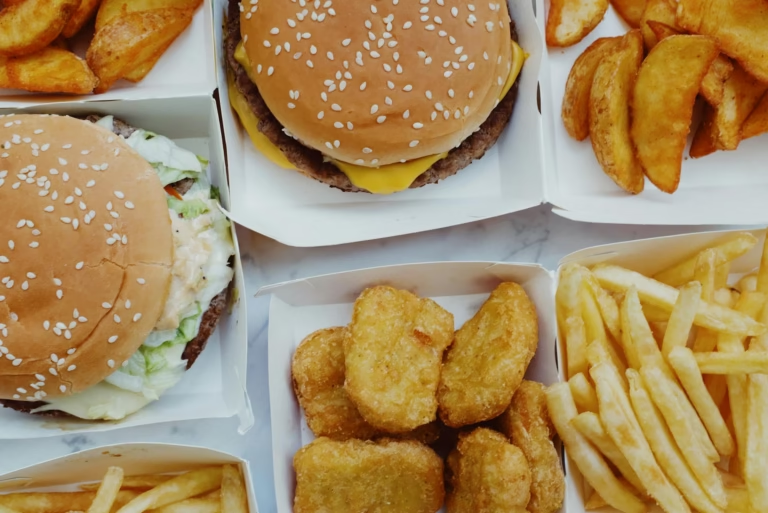
What foods do not contain any fiber?
Animal Products
Meat (beef, chicken, pork, turkey, lamb), Fish (salmon, tuna, cod, etc.), Eggs, Dairy products (milk, cheese, yogurt, butter).
Highly Processed Foods
White bread, white rice, regular pasta (made with refined flour), Pastries, cakes, cookies made from white flour, processed snacks like potato chips (very low to no fiber). Processing removes the bran and germ, which are the fiber-rich parts of grains.
Oils and Fats
Vegetable oils (olive oil, canola oil, coconut oil), butter, and margarine. These are pure fats with all fiber removed in the processing.
Sugary Foods
Candy, soda, syrups, and ice cream are mostly sugar and fat.
If a food comes only from animals, pure fat, or is heavily processed, it usually has no fiber, so make sure to eat more unprocessed plant foods to hit your recommended daily amount.
Conclusion
Dietary fiber is an essential component of a healthy diet.
It offers many health benefits, including improved metabolic and cardiovascular health, enhanced gut function, and reduced risk of chronic diseases. It is easy to increase our daily fiber by simply eating more whole plant-based foods.
Share this simple list with someone who could benefit from it!

Bonus: How to Get More Fiber in Your Dog’s Diet
Fiber is as important to our dogs as it is to us; it helps with digestion and keeps their microbiota healthy. (8)
Fiber-Rich Foods That Are Safe for Dogs:
Vegetables (Cooked or Steamed):
Pumpkin (plain, cooked, or canned), Sweet potatoes (cooked, no skin), Carrots (raw or cooked), Green beans, Broccoli (small amounts), Zucchini.
Fruits (in moderation):
Apples and pears (no seeds or core), Blueberries, Bananas.
Grains and Legumes (cooked, plain):
Brown rice, Oats (plain, cooked), Lentils (well-cooked, small amounts), Quinoa (cooked, plain).
There are some simple ways to introduce more fiber to your dog’s diet:
Pumpkin: Slightly boil pumpkin, freeze portions, and use as bowl toppers or treats.
Flax seeds: Sprinkle a small amount onto food (in moderation).
Fresh treats: Use apple slices or carrots instead of processed treats. They’re healthy, low-calorie, and dogs love them!
Important tip: Introduce fiber slowly to avoid upsetting their stomachs. Only feed your dog plain food without any seasonings like salt or pepper.
Fiber-Rich Foods That Are Dangerous or Risky for Dogs:
Onions and garlic (and all forms, including powder) are toxic to dogs
Raisins and grapes are highly toxic and can cause kidney failure
Avocados – contain persin, which can upset dogs’ stomachs
Cherries (especially pits and stems) – toxic and a choking hazard
Rhubarb – toxic to dogs
Unripe tomatoes/tomato plants contain solanine, which is harmful.
Nuts, many are toxic or cause GI upset.
References
- Barber, T., Kabisch, S., Pfeiffer, A., & Weickert, M. (2020). The Health Benefits of Dietary Fibre. Nutrients, 12. https://doi.org/10.3390/nu12103209.
- Cronin, P., Joyce, S., O’Toole, P., & O’Connor, E. (2021). Dietary Fibre Modulates the Gut Microbiota. Nutrients, 13. https://doi.org/10.3390/nu13051655.
- Alahmari, L. (2024). Dietary fiber influence on overall health, with an emphasis on CVD, diabetes, obesity, colon cancer, and inflammation. Frontiers in Nutrition, 11. https://doi.org/10.3389/fnut.2024.1510564.
- Cronin, P., Joyce, S., O’Toole, P., & O’Connor, E. (2021). Dietary Fibre Modulates the Gut Microbiota. Nutrients, 13. https://doi.org/10.3390/nu13051655.
- He, Y., Wang, B., Wen, L., Wang, F., Yu, H., Chen, D., Su, X., & Zhang, C. (2022). Effects of dietary fiber on human health. Food Science and Human Wellness. https://doi.org/10.1016/j.fshw.2021.07.001.
- https://nutrition.org/most-americans-are-not-getting-enough-fiber-in-our-diets/
- Augustin, L., Aas, A., Astrup, A., Atkinson, F., Baer-Sinnott, S., Barclay, A., Brand-Miller, J., Brighenti, F., Bulló, M., Buyken, A., Ceriello, A., Ellis, P., Ha, M., Henry, J., Kendall, C., La Vecchia, C., Liu, S., Livesey, G., Poli, A., Salas‐Salvadó, J., Riccardi, G., Risérus, U., Rizkalla, S., Sievenpiper, J., Trichopoulou, A., Usic, K., Wolever, T., Willett, W., & Jenkins, D. (2020). Dietary Fibre Consensus from the International Carbohydrate Quality Consortium (ICQC). Nutrients, 12. https://doi.org/10.3390/nu12092553.
- Bhosle, A., Jackson, M., Walsh, A., Franzosa, E., Badri, D., & Huttenhower, C. (2024). Response of the gut microbiome and metabolome to dietary fiber in healthy dogs. mSystems, 10. https://doi.org/10.1128/msystems.00452-24
- Grube, B., Chong, P., Lau, K., & Orzechowski, H. (2012). A Natural Fiber Complex Reduces Body Weight in the Overweight and Obese: A Double-Blind, Randomized, Placebo-Controlled Study. Obesity (Silver Spring, Md.), 21, 58 – 64. https://doi.org/10.1002/oby.20244.
Silvija Meilunaite, PN1-NC, CSMC, is a certified nutrition and menopause coaching specialist, and a writer in the nutrition and self-improvement field. She explores science-based approaches to holistic health and plant-based nutrition, with a strong focus on researching clean, non-toxic products that support long-term well-being.
- S. Meilunaitehttps://barefootbasil.com/author/silvootegmail-com/
- S. Meilunaitehttps://barefootbasil.com/author/silvootegmail-com/
- S. Meilunaitehttps://barefootbasil.com/author/silvootegmail-com/
- S. Meilunaitehttps://barefootbasil.com/author/silvootegmail-com/



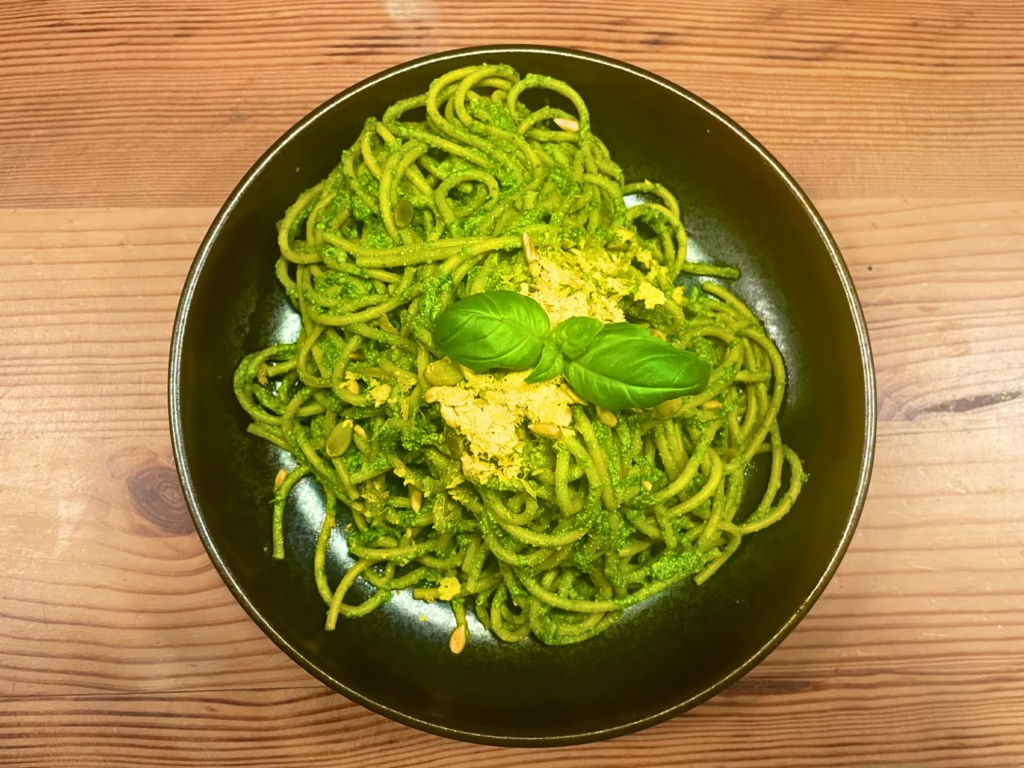

Including high fiber foods for babies can support healthy digestion and help prevent constipation naturally.
Absolutely, fibre is as important to babies as to adults.